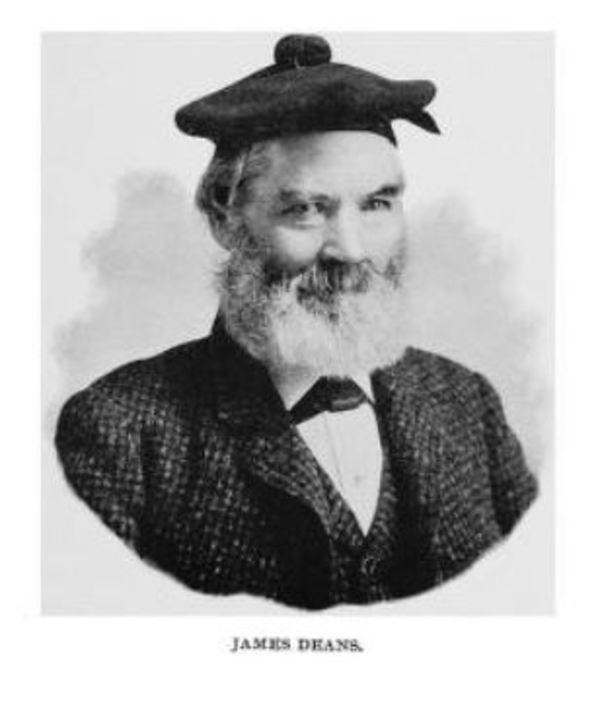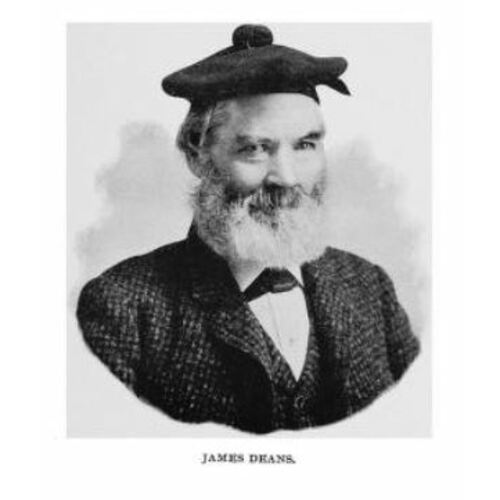
Source: Link
DEANS, JAMES, farmer, mining explorer, researcher on native subjects, and author; b. 17 June 1827 in Haddington, Scotland, son of Alexander Deans and Jane Hunter; m. 11 Feb. 1864 Catherine Bullion in Victoria; they had no children; d. 17 July 1905 at his home near Victoria.
James Deans had little formal schooling, “the extent of it being a little of the three Rs,” he wrote. He worked for a time on an estate near Gifford, Scotland, and then, in 1847, was employed by Kenneth McKenzie* at the latter’s Rentonhall tile works. In 1852 he decided to follow McKenzie, the newly appointed bailiff for one of the Hudson’s Bay Company’s farms on southern Vancouver Island. Departing from London, he was under the standard five-year labourer’s contract of £17 a year and price concessions at the company’s stores.
After arriving in Victoria on 16 Jan. 1853, he worked initially at the fort store, and then, with other single men, was sent to McKenzie’s Craigflower Farm. He later was transferred to the Lakehill Farm. At the end of his contract, in August 1857, he began, with his brother George, a farm near Mount Tolmie, not far from Victoria. The bewhiskered Deans, wearing his tam, was a colourful character around the town, where over the years he was to be active in the St Andrews and Caledonian and the Natural History societies.
Although he took an initial interest in farming, Deans soon demonstrated a roving character and. intellect. In 1862 he visited Fort Simpson (Port Simpson) and the Stikine mines (B.C.), and three years later he applied unsuccessfully for appointment to the Vancouver Island Exploring Expedition [see Robert Brown*], claiming “a thorough knowledge of Indian Character, also an acquaintance with the languages of several tribes, along the East coast of this Island,” as well as experience of minerals and an instinctive knowledge of botany and of the quality of soils. The years 1869, 1870, and 1872 found him in the Queen Charlotte Islands working for the Queen Charlotte Coal Company at Skidegate Inlet. In 1882 (and probably more often) he was again on the Charlottes in connection with coal exploration. The following year he joined James Gilchrist Swan, an artefact collector under commission from the Smithsonian Institution, and Chief Eda’nsa* on a canoe trip there, from Masset around the east coast of Graham Island to Skidegate. Apparently Deans was himself under commission from Dr Israel Wood Powell*, superintendent of Indian affairs in Victoria, to investigate native reserves and difficulties, upon which he duly reported.
Deans’s expertise brought a commission from Franz Boas* to collect Haida material for the ethnology department of Chicago’s Columbian exposition. He spent the spring and summer of 1892 on the Charlottes, returning with enough artefacts to fill three boxcars. Included were a Skidegate house and a 42-foot pole, as well as a set of 43 models that reconstructed Skidegate village at its 1864 prime. He then accompanied George Hunt* and a party of 17 Kwakiutl to Chicago for the duration of the 1893 fair. In 1897, now 70, Deans worked with George Amos Dorsey, curator of Chicago’s Field Columbian Museum, on an expedition to the north coast and the Charlottes.
Deans’s active, if untrained, intellect had shown itself as early as his Craigflower Farm days when he had lectured his fellows on the nobility of man, the phases of the moon, and the Anglo-Saxon race. His later, written contributions increasingly dealt with native subjects, especially the Haida and their mythology and the prehistoric cairns and mounds of southern Vancouver Island. As early as 1871 he had opened some cairns at Cadboro Bay and he continued with this work intermittently, including assisting Alphonse-Louis Pinart, a French anthropologist who visited Victoria in 1876. In 1886 he began submitting contributions on prehistory and mythology to journals, largely the American Antiquarian and Oriental Journal (Chicago) and the Journal of American Folk-Lore (Boston and New York); by 1900 he had published some 44 notes and articles, some of which formed the basis for his Tales from the totems of the Hidery, published in Chicago in 1899.
Although Deans’s writings were often the earliest reports on their subjects, they did not wear well. Filled with speculative Old World and pan-American connections, his work was soon outdated by professional research, especially that done by the American Museum of Natural History’s Jesup North Pacific Expedition after 1897. More enduring are his collections, largely housed at the Field Museum of Natural History (formerly the Field Columbian Museum) and the Royal British Columbia Museum in Victoria.
James Deans’s Tales from the totems of the Hidery was edited by Oscar Lovell Triggs and published in 1899 under the auspices of the International Folk-Lore Assoc.; it has been reprinted ([Norwood, Pa], 1974). Nine other works by Deans on native subjects are available on microfiche through the CIHM and are listed in its Reg. In addition to the many articles he published on prehistory and mythology, Deans contributed three items on farming to the Victoria Daily Colonist, 11 April, 10 Sept., and 7 Oct. 1861.
Bancroft Library, Univ. of Calif. (Berkeley), A. [-L.] Pinart papers, diary. BCARS, Add. mss 2431; A/E/P87/D34; E/B/D342; G/V/V27.1; GR 1304, file 1906/2923; S/B/D34; W/D341 S. Field Museum of Natural Hist. Arch. (Chicago), Accession records, Acc. 21; File information on collections assembled by Deans. First United Church (Victoria), First Presbyterian Church, reg. of marriages, 11 Feb. 1864. Smithsonian Institution Arch. (Washington), RU 70, J. C. Swan to S. F. Baird, 27 April 1883. Douglas Cole, Captured heritage: the scramble for northwest coast artifacts (Vancouver and Toronto, 1985). G. A. Dorsey, “A cruise among Haida and Tlingit villages about Dixon’s Entrance,” Appletons’ Popular Science Monthly (New York), 50 (May–October 1898): 160–74.
Cite This Article
Douglas Cole, “DEANS, JAMES,” in Dictionary of Canadian Biography, vol. 13, University of Toronto/Université Laval, 2003–, accessed January 11, 2026, https://www.biographi.ca/en/bio/deans_james_13E.html.
The citation above shows the format for footnotes and endnotes according to the Chicago manual of style (16th edition). Information to be used in other citation formats:
| Permalink: | https://www.biographi.ca/en/bio/deans_james_13E.html |
| Author of Article: | Douglas Cole |
| Title of Article: | DEANS, JAMES |
| Publication Name: | Dictionary of Canadian Biography, vol. 13 |
| Publisher: | University of Toronto/Université Laval |
| Year of publication: | 1994 |
| Year of revision: | 1994 |
| Access Date: | January 11, 2026 |



